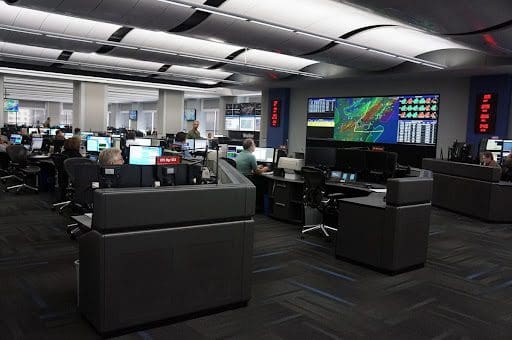
Control room consoles and console design have a surprisingly large effect on operators’ comfort, safety, and productivity. Read on to learn how to design an ergonomic control room workstation that supports productivity and helps employees stay focused during long shifts in high-intensity climates.
What Are Control Room Consoles?
Control room consoles are specialized workstations used in control centers, including 911 dispatch centers and air traffic control settings. They are typically built to high ergonomic standards with design choices that meet the unique needs of mission-critical organizations.
Designing a successful control room console starts with understanding the user’s needs and pain points. The design must be practical in a control room with multi-monitor workstations, large pieces of equipment, and special lighting challenges.
What Features Are Important in Control Room Consoles?
When designing control room consoles, it is vital to make sure operators will be able to easily access everything they need and avoid clutter from technology.
Below are just a few important control room console features that can make a difference in employees’ lives:
Surface and Monitor Adjustments
Since different employees have different heights and proportions, it’s important for workstations to have adjustable surfaces and monitors. Ideally, work surfaces should be able to move from an ergonomic height for both the shortest and tallest employees in either a sitting and standing position. The goal is to ensure that all operators are comfortable while maintaining their monitor viewing angles from all postures and positions.
Control consoles should allow users to have their feet flat on the ground with their arms roughly parallel to the ground. This setup encourages good posture, which contributes to operators’ overall health and well-being.
Area Space
Control room workspaces need to have surfaces that can support all of their frequently used tools and materials within relatively close reach zones. Ideally, all of the equipment an operator needs should be within arm’s reach and stored in a safe place without cluttering up the work surface.
Temperature and Lighting Controls
All control room consoles should have user-controlled lighting, heating, and cooling controls to ensure their comfort throughout their shifts. Control rooms with poor lighting or cold temperatures lead to employee frustration, complaints, and potentially higher absentee rates. Allowing operators to control their lighting and temperature helps them create an environment where they can stay focused during long and arduous work shifts.
Lighting that is too bright can cause eye pain and fatigue, especially at night or in dim environments. However, lighting that is too low can be dangerous when moving around, and it often makes it harder for operators to use their equipment and materials.
While sunlight is the safest form of surface light for eyes, it can often bounce off of monitors and make seeing monitors difficult, and open windows may compromise security. Task lighting proves to be especially important in control rooms because it allows localized light on the most important spaces. This type of lighting spotlights only what needs attention, allowing employees to stay focused on their monitors.
Console Positioning
Control room operators must be able to react quickly in high-intensity environments and work together as a team. This is why it’s so important to position all control room consoles appropriately so that every station has clear lines of sight to shared monitors and close team members.
How to Design a Control Room in 2021
The best way to start when designing a control room in 2021 is to talk to the intended users. At Russ Bassett, we like to get input from current operators to learn about pain points and function needs that management may not be aware of.
No one knows more about an operator's workstation than an operator themselves. If you’re planning on building a control room, make sure to ask your employees what could be improved about their current workstations.
You will also need to think about the configuration of the room. Many organizations strategically space out their workstations to ensure that excessive noise does not travel or disrupt other employees, and you may need to add additional space for social distancing during the pandemic. At the same time, you will need to consider lines of sight and communication between console users.
Don’t assume you can just copy and paste another organization’s design concept. Every control room team has different specific needs for their workspaces. Every organization is different, and their control room consoles should be too. Your team’s unique operational priorities, business processes, and organization needs should all be integrated into the design process.
Call Russ Bassett to Get Started on Your Control Room Design Project
Russ Bassett has been in the furniture business since the 1960s. Our dispatch workspaces and control room consoles are designed with the best PSAP amenities on the market to tailor to every operator’s needs. We work with employees to create customizable features and sleek, thoughtful designs to keep everyone safe and comfortable during long shifts.
All Russ Bassett products have a 10-year warranty, so you can be sure your office workspaces are made for decade-plus performance. Call Russ Bassett today to see what we can do for you!